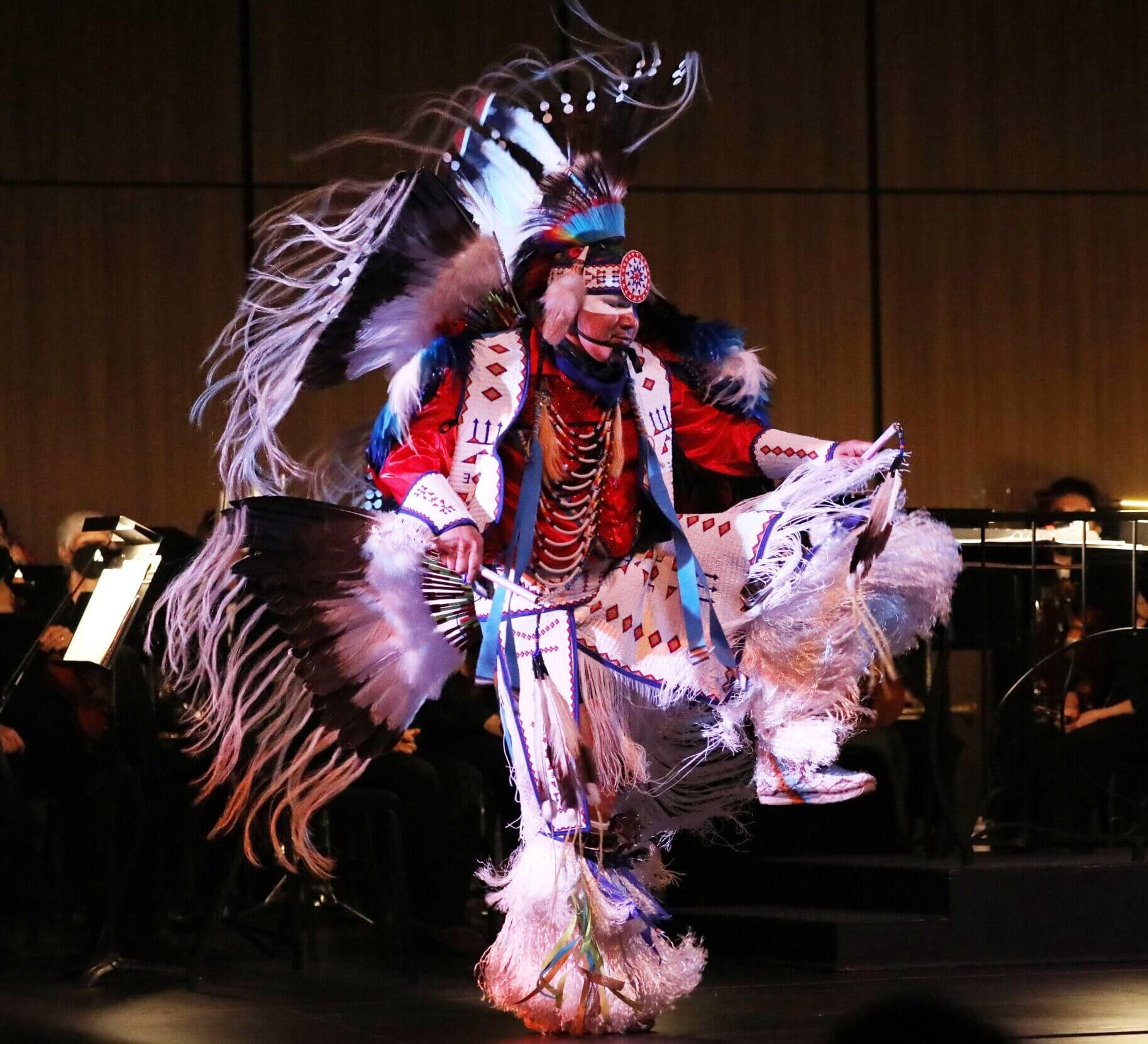Events

Classic Series
THE LONG WALK HOME
Saturday
Feb 15, 2025
7:30PM
Alberta Bair Theater
2801 3rd Ave N
Join us for a multifaceted celebration of Montana’s vibrant Native American culture. Through a rich tapestry of origin stories, dance, and music—traditional and symphonic—The Walk Home explores who we are, where we are, and where we’re going. Our varied ensemble of special guests includes members of the Northern Cheyenne, Oglala Sioux, Umatilla, and Mandan tribes.
Doors open: 6:30PM
Pre-Concert Cues: 6:40PM
- The Northern Cheyenne were once part of the Cheyenne Tribe. The tribe lived predominantly in what is now Minnesota, later migrating to the Dakota territory. They were a hard-working, nomadic people with a deep knowledge of and appreciation for the land. Clothing, shelter, bags and equipment were made from buffalo and other animals they hunted. Plants and leaves were gathered and used for food and medicines.
- The drum is one of the most important things to the Native American culture, because the culture centers around the drum. The drum is the heartbeat of the Earth Mother, and drumming brings everyone back into balance. Through dancing, singing and listening the people around the drum can connect with spirits.

ABOUT THE PROGRAM
WALTER RUNSABOVE
We’re Going Home
Written originally for Native flutes alone, Runsabove graciously allowed his work to be transcribed to include classical flutes and Billings Symphony musicians. The flutes represent the different chiefs as they discussed whether they should risk the lives of their tribal members to escape from their forced location in Oklahoma where they were starving and dying from malaria. The Long Walk Home tells the story of their journey from Oklahoma to Nebraska and to what eventually became the Northern Cheyenne reservation in Montana.
BEDŘICH SMETANA (1824–1884)
Vltava (The Moldau) from Má vlast (My Fatherland)
Between 1874 and 1880, Smetana wrote Má Vlast, a collection of six tone poems, which each depict an important aspect of Czech history or geography. In the second of the six works, the composer, uses the colors of the symphony to evoke the course of the Vltava (Moldau) river, as explained in his own program notes:
“Two springs pour forth in the shade of the Bohemian forest—one warm and gushing, the other cold and peaceful. Coming through Bohemia’s valleys, they grow into a mighty stream. Through the thick woods it flows as the merry sounds of a hunt and the notes of the hunter’s horn are heard ever closer. It flows through grass-grown pastures and lowlands where a wedding feast is being celebrated with song and dance. At night, wood and water nymphs revel in its sparkling waves. Reflected on its surface are fortresses and castles—witnesses of bygone days of knightly splendor and the vanished glory of martial times. The Vltava swirls through the St. John Rapids, finally flowing on in majestic peace toward Prague to be welcomed by historic Vyšehrad. Then it vanishes far beyond the poet’s gaze.’’
Vltava has appeared on a handful of Billings Symphony programs, all during Maestro Uri Barnea’s tenure: in February 1986 and twice in January 2000.
JEROD IMPICHCHAACHAAHA’ TATE (b. 1968)
Chokfi’ (Sarcasm for String Orchestra and Percussion)
The son of a Chickasaw father and an Irish mother, Jerod Impichcha̱achaaha' Tate grew up in a family professionally involved in music, dance and theatre. He earned his Bachelor of Music in Piano Performance from Northwestern University and his Master of Music in Piano Performance and Composition from The Cleveland Institute of Music. Inspired in ways of combining ethnic and Classical traditions through the music of Bela Bartók, Tate writes: "I didn't mix my identities of being a classically trained musician and being an American Indian. I never saw that there was even a possible relationship between those two until I started composing. And that's when they came together in a way that made me feel just wonderful.”
Chokfi’ (choke-fee) is the Chickasaw word for rabbit, who is an important trickster legend within Southeast American Indian cultures. Inspired by a commission for the Oklahoma Youth Orchestras, the composer decided to create a fun and challenging character sketch which uses different string and percussion techniques and colors to represent the complicated and diabolical personality of this rabbit person. In honor of his Muscogee Creek friends, Tate incorporated a popular tribal hymn as the melodic and musical base.
While tonight’s performance of Chokfi’ is a Billings Symphony premiere, it is not the first time Tate’s work has appeared on a BSO program. In October 1995, with the composer in residence, the orchestra performed a suite from his ballet, Winter Moons.
ANTONÍN DVOŘÁK (1841–1904)
Symphony No. 9 (From the New World): III. Molto vivace [Shanna, only 3rd paragraph is new]
A wave of artistic nationalism swept over much of Europe in the 19th century. In the United States, while literature had already established a unique voice, the other arts, particularly music, lagged behind, still dominated by models inherited from overseas. Jeanette Thurber, wife of a wealthy New York merchant, aspired to change this and founded the National Conservatory of Music in 1888. Created for African American musicians, the Conservatory focused on the study of African American and Native American music. Thurber sought out Antonín Dvořák to head her new Conservatory because of his fame and his deep interest in folk and traditional music. He was initially reluctant, but when Thurber offered him a salary five times what he was making in Prague, he gave in, assuming leadership in September 1892.
His teaching and administrative duties initially left him little time for composing, but toward the end of December, he began jotting down ideas for a new symphony. The completed symphony, which Dvořák titled, From the New World, premiered a year later to immediate acclaim on December 16, 1893, with Anton Seidl conducting the New York Philharmonic Society at Carnegie Hall.
The first classical composer to recognize and attempt to embody what he thought of as Native American culture, Dvořák challenged critics who did not think that the music of nonwhite peoples deserved such prominence. Ironically, it is unlikely that Dvořák actually heard Native American music until after the symphony was completed. Rather, the dance-like theme of the third movement was inspired by a passage from Henry Wadsworth Longfellow’s poem, The Song of Hiawatha.
Dvorák’s symphonic “impressions and greetings from the New World” has been a popular programming choice of Billings Symphony conductors. The complete work has appeared on 10 BSO programs—from the finale of our second full season (1952–1953) under the baton of founder Maestro Robert Staffanson to the April 2021 season finale during the pandemic with a reduced orchestration.
Dvorák’s symphonic “impressions and greetings from the New World” has been a popular programming choice of Billings Symphony conductors. The complete work has appeared on ten BSO programs—from the finale of our second full season (1952–1953) under the baton of founder Maestro Robert Staffanson to the April 2021 season finale during the pandemic with a reduced orchestration.
WILLIAM WALTON (1902–1983)
Touch her soft lips and part from Henry V
Composer William Walton was doubtful of the value of film music when heard without the screen images it was written to accompany, opining, “Film music is not good film music if it can be used for any other purpose.” In a rare exception, he allowed two self-contained sections of his film score for the 1944 Laurence Olivier film, Henry V, to be played in concert: the passacaglia, "Death of Falstaff" and "Touch her soft lips and part,” both for strings only.
The musical themes for the film follow the intense drama of this cinematic rendition of Shakespeare’s masterpiece, from royal processions and fierce battles to the private and tender moments between the monarch and Princess Katherine, to whom Henry was betrothed as part of a brokered peace treaty. Touch her soft lips and part accompanied the scene where the soldiers are departing for France and saying goodbye to their women.
Walton’s poignant underscore first and previously appeared on the March 2013 A Royal Celebration concert, under the baton of Maestra Anne Harrigan.
AYALA ASHEROV (b. 1968)
Cycles of the Moon
Israeli-born composer Asherov composed this multi-movement work for solo viola and strings while on a retreat in “the magical mountains of North Carolina” in the spring of 2010. “I was living without time constraints, following the moon, the rising sun, and the movement of the leaves in the wind. All five movements were written during the first week of May, which by the Native American Lunar Cycles is called ‘Flower Moon.’” As the title suggests, Asherov’s rich and evocative writing takes the listener through different phases of the moon, each one representing various aspects of life—like love, loss, and renewal.
ALAN HOVHANESS (1911–2000)
Mount St. Helens Symphony (Symphony No. 50): III. Volcano. Adagio—Allegro—Adagio
"When Mount St. Helens erupted on the morning of May 18, 1980, the sonic boom struck our south windows. Ashes did not come here at that time but covered land to the east all across the State of Washington into Montana. Ashes continued to travel all around the world, landing lightly on our house a week later, after their journey all around our planet. In my Mount St. Helens Symphony, I have tried to suggest a musical tribute to the sublime grandeur and beauty of Mount St. Helens and the surrounding majestic Cascade Mountains." – Alan Hovhaness
While the first two movements (not performed tonight) represent the mountain and nearby Spirit Lake as they were, the third and final movement represents the volcano eruption itself. The opening Adagio is a calm hymn presented by strings and ornamented by the celesta, representing the tranquil morning of the day everything happened. As the piccolo briefly reprises the theme in pianissimo, it is cut off by a massive percussive outburst. The brass introduces the menacing and dissonant theme of the mountain's explosion which is quickly followed by a violent passage of controlled chaos by the whole orchestra. Brass and percussion turn the menacing theme into an imposing march until the violence fades away just enough for the opening hymn to burst through. This new song of praise to the mountain soon becomes a joyful fugue in the strings. Not willing to be left out, winds, brass and percussion join in and the dawn hymn is transformed a final time into its final, most expansive version—the orchestra resounding like a symphonic organ with all-out full stops.
Tonight’s performance is a Billings Symphony premiere. Previous Hovhaness symphonies performed are his Mysterious Mountain (No. 2) in March 1963 under the baton of Maestro George Perkins, and City of Light (No. 22) almost conducted by the composer himself ten years later in March 1973, until he had to back out due to illness. The most recent Hovhaness work performed with his And God Created Great Whales—a symphonic poem for orchestra and recorded whale sounds—in September 2000 under the baton of Maestro Uri Barnea.




